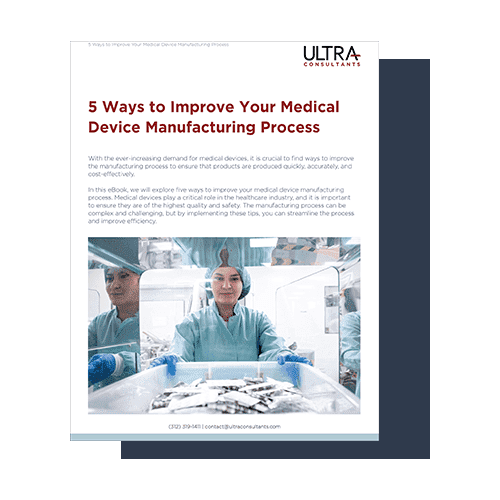With the increasing demand for innovative medical devices and the constant advancements in technology, it’s important to look ahead and anticipate what the future may hold. Here are some medical device manufacturing trends for 2024 we can expect to see.

5 Ways to Improve Your Medical Device Manufacturing Process
The manufacturing process can be complex and challenging, but by implementing these tips, you can streamline the process and improve efficiency.
Internet of Things (IoT)
The Internet of Things refers to the interconnectivity of devices through the internet. As manufacturing continues to be challenged with increasing efficiency and productivity while containing costs, sensors and connectivity provided by IoT promises to help optimize production and reduce costly downtime.
For example, collecting data from equipment and machines allows visibility to trends and areas for improvement. Plus, IoT provides key metrics of production processes in real-time. These capabilities deliver faster reporting and identification of problems, speeding data-driven decision making and continuous improvement.
In the medical device manufacturing industry, integration of IoT into medical devices collects and transmits data to healthcare providers. This data can be used to monitor patients, track their progress, and adjust treatment plans accordingly. Additionally, IoT can be used to track medical devices and ensure that they are functioning properly. This can help to prevent equipment failures and improve patient safety.

3D Printing
One of the most significant advancements in the medical device manufacturing industry is 3D printing, also called additive manufacturing. This technology has revolutionized the industry by enabling the production of complex and customized medical devices.
3D printing is the process of building up successive layers of raw material to create a three-dimensional object. Each new layer is added to the previous layer until the object is complete. Objects are created from 3D digital files such as CAD (computer-aided design) drawings and magnetic resonance images (MRI).
With 3D printing, the production of medical devices has become faster and cheaper. Furthermore, the technology allows for the production of devices that are tailor-made for a specific patient, personalized to their unique needs.
Artificial Intelligence (AI)
For medical device manufacturers, AI has the potential to help decrease defects and increase yield while boosting employee efficiency. But since AI is dependent on data, the production facility must have integrated systems that capture accurate data without human error.
Another area where AI could offer competitive advantages for medical device manufacturers is in analyzing data to identify trends. Again, the prerequisite digital transformation must be in place for AI to be successful. With the right business intelligence systems, AI can aid in improving product quality and ensuring patient safety.
Perhaps the most potential for AI in the medical device industry lays in the devices themselves. As explained in a recent article from datafloq.com, “AI-capable devices can make health care more accessible, improve diagnoses and boost medical response times.” Manufacturers who embrace these capabilities can see increased demand for AI-enhanced products.

Robotics
Robotics is another technology trend that is expected to shape the medical device manufacturing industry. From the production line to the operating room, robotics in healthcare offers efficiency and precision that are frequently impossible for human hands to attain.
For example, manufacturing facilities have struggled for a very long time with contamination problems brought on by human workers. Robots make it possible to eliminate humans from many production areas. Medical devices demand high levels of precision in addition to sanitation. Extreme dexterity that a human worker cannot consistently duplicate is possible using robots.
Another area of production where robots are proving an invaluable asset is in worker safety. The use of robots to grind, deburr, and package medical sharps lowers the possibility of workplace accidents, while employees concentrate on overseeing operations.
Cybersecurity
As more medical devices become connected to the internet, cybersecurity has become a major concern. Medical devices are susceptible to cyber-attacks, which can compromise patient data and patient safety.
Recent research “has found an average of 6.2 vulnerabilities per medical device and that 40% of medical devices at the end-of-life stage offer little to no security patches or upgrades.”
Effective cybersecurity practices require constant vigilance to reliably identify and mitigate all risks and prevent damage to equipment and patients. Manufacturers looking to enhance device cybersecurity should ensure adequate oversight by delegating responsibilities to senior positions such as vice presidents and medical device security officers.
Conclusion
The medical device manufacturing industry is experiencing a significant technological shift. New technologies have the potential to improve patient outcomes, reduce costs, and increase efficiency. As the medical device manufacturing industry continues to evolve, we expect to see more advancements that will revolutionize healthcare. For expert advice on how to maintain a competitive edge in your medical device manufacturing operation, turn to Ultra Consultants.
Table of Contents
More ERP material...
AI in Food and Beverage Manufacturing
Discover how AI is revolutionizing food and beverage manufacturing, enhancing quality, reducing…
How ERP for Quality Control Eliminates Manual Documentation Chaos
This post will examine why managing quality records outside of an ERP…
Assessing Your AI Maturity
This article breaks down how businesses can measure their AI maturity to…



